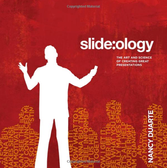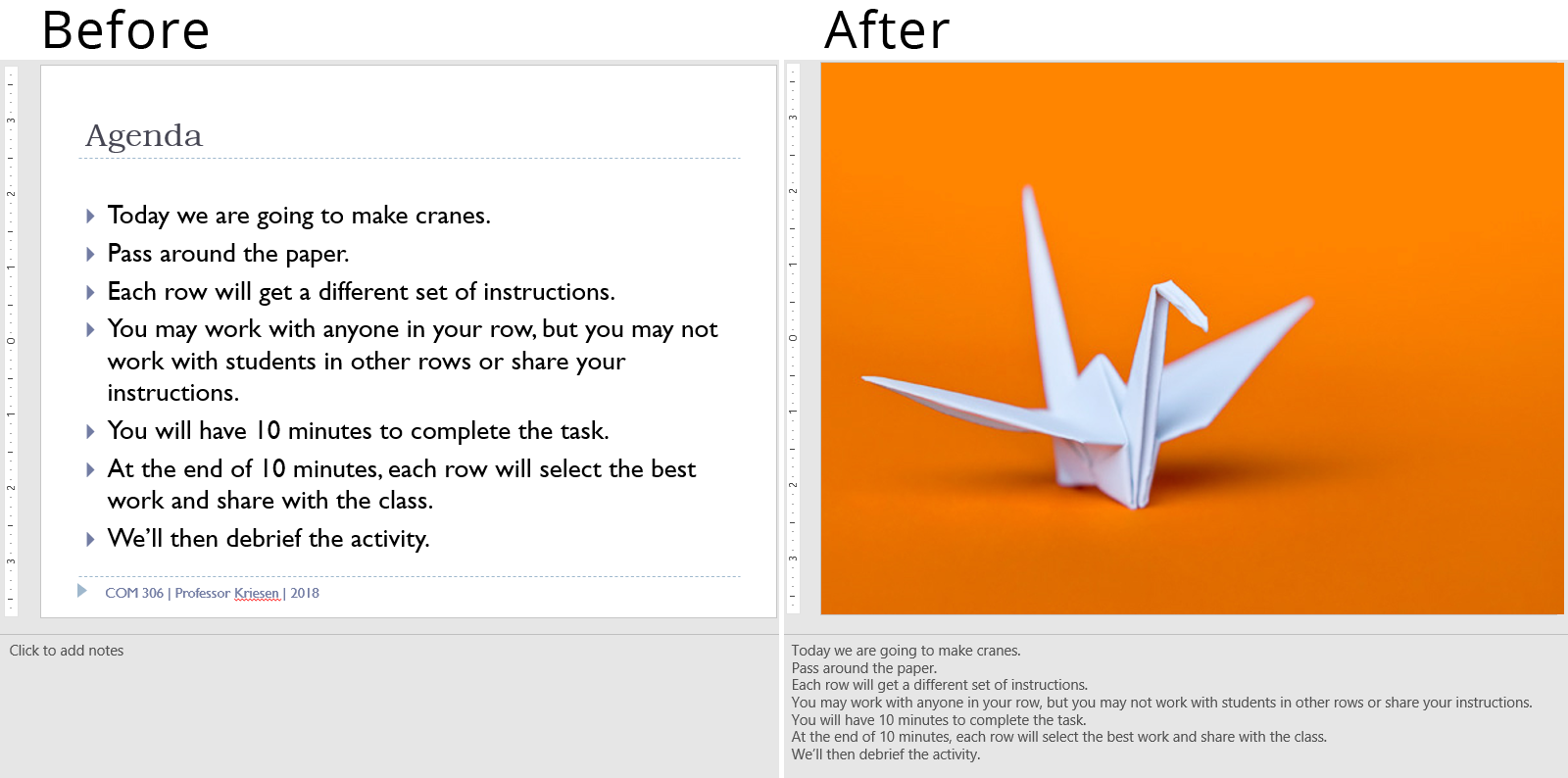|
Solutions Arts’ team member, Gretchen Kriesen is on a first-name basis with the angst and stress that can accompany public speaking and presenting. She wears multiple hats at and outside of Solutions Arts. As our lead project manager, she skillfully shepherds projects from concept to implementation, maneuvers obstacles with aplomb, communicates effectively with both clients and project teams, and does all this with a killer sense of humor. Gretchen is also our design guru and document architect. She shares her deep skill set and years of experience in design with her undergraduate students at SUNY Polytechnic Institute. For years, Gretchen has been teaching a variety of communication courses where she combines theory and practice and draws a great deal from her successful career to prepare students for the real world. Knowing all of this, it might be surprising to learn that Gretchen dislikes public speaking and presenting. We thought: who better to speak on this topic from a personal experience and demonstrate how these best practices and tips apply to the real world? We asked her to share her journey and how she overcomes her presenting fears to give life to what we’ve been discussing in these two articles on presentation skills. I hated presenting. “Hate” isn’t quite right. I loathed it. I loathed it with every fiber of my being. I loathed it more than making dinner every night for the past four months because we can’t go out to eat. I didn’t even like answering questions in school (constant feedback: “Does not participate in class”). I’m not a huge participant in meetings, either. Given the choice, I wouldn’t speak in front of a crowd. Ever.
And yet, I teach. Ironically, I teach a course in public speaking. For the first year, I began each and every teaching day the same: after a sleepless night, I spent my mornings wondering why I was doing this as I checked over my notes and my decks. During my drive, I continued to stress out and review my presentations. When I got to campus, my heart rate went into hyper-drive as I walked to my room. Sometimes I hoped the class was cancelled (yes, sometimes instructors want the classes cancelled, too). By the time I had my hand on the door handle, I was deeply resisting running away and hiding in my car. I was out of breath and sweating. And then I walked in. I just … did it. Over and over again. And it got easier. It’s true! Along with all of the tips we’ve talked about in the last two articles, I kept asking myself why I was teaching, why I was doing this thing that scared me, top of mind. You see, I teach because I believe I can help my students prepare for their careers. That’s why I’m there: for them. They are worth the stress. I think this attitude—that, at the very least, the audience isn’t the enemy, really helps keep the anxiety from being overwhelming. Even with the right attitude, the key to my presentation style is to establish a positive environment and for my talk to feel more like a conversation (one in which I might be hogging the discussion). I do this by connecting with my students and encouraging them to connect with each other. I make sure my examples and vocabulary relate to them; I give them lots of group activities to help them learn and get to know and trust each other. The result (ideally) is interested and engaged audience members who participate and learn. (Sometimes the result is that I epically mess up and we all laugh and move on. When you establish the right environment, mistakes are forgiven.) Let me underscore that stress is not the enemy. I teach online sections of my classes (both before the pandemic and because of the pandemic). And guess what? No stress. Know what else? I’m less effective. That’s not just my self-assessment; I see it both in the quality of work from my students as well as in the evaluation scores they give me. I think that the lack of stress results in less enthusiasm and less of a connection with my students. So, while I like the angst-free mornings when I teach online, I think that the lack of nervousness works against me and I have to work harder to create the same energy. (And while we’re here, teaching effectively online means changing your lesson plan, decks, and pacing. You have to get creative and work with the software to even come close to the connections you get in a traditional classroom. It isn’t as simple as slapping the same content into Zoom and running with it. Ask any teacher or professor and they’ll tell you the same.) I still get nervous, but it’s not paralyzing. I still stress-sweat, but it’s not a big deal. The first day of classes is harder than the last. Some days in between are great. Some fall flat. But each time I get up there, I learn a little more and I get a little better. It does get easier. I tell my students all the time: the more you get up there and do it, the better you’ll be. It’s a combination of honing your skills, learning what works for you, and being able to look back and say, “I’ve already done this so I know I can do it again.” As with most things, it takes practice and focus. And maybe a little bit of angst. Gretchen Kriesen is an adjunct lecturer at SUNY Polytechnic Institute and a business and design consultant for Solutions Arts. She also took a Buzzfeed quiz that told her she was funny, so she’s added that to her resume.
0 Comments
This is the second in a two-part blog about presentation design and delivery. Click here to read last week’s installment. Part II: Preparing Your Delivery. You’ve got your deck. You’ve got your notes. Now it’s time to focus on your delivery.  Non-verbal Communication Approximately 93% of the message you deliver is nonverbal.¹ That means the content is just 7% of what you’re communicating. The rest includes your oral tactics/tonality, pacing, facial expressions, body language, eye contact, and so on. You know what that means then: if your non-verbal communication is lacking, the best content will only get you so far. Unfortunately, the delivery just so happens to be the part that tends to stress folks out the most. Creating the presentation or writing the speech is usually not the big issue. Delivering it is. Much of presentation fear is about the unknown. Will I mess up? Will I not know an answer? Will they not like me? Will they laugh at me? Will I simply not be good? All these questions can set your nerves into overdrive and derail your presentation, but only if you let them. So, what can you do? Channel the Nervous Energy First, don’t expect nerves to completely go away. While you will (and you will) get more comfortable as you present more often, most people continue to have some nerves before a presentation. The good news is that you can channel those nerves to improve your delivery. That’s right: the goal isn’t necessarily to squash your nerves, but to use them to your benefit. Nervous energy can translate into positive energy. And you need positive energy to deliver effectively. If you’re flat, you probably sound bored by your own content. Guess who else will probably be bored? Yep. The audience. If you portray interest and excitement, that, instead, is likely to transfer to them. Also, getting in some cardio before you deliver can help drain some excess anxiety. Something as simple as running up the stairs before your presentation can help decrease angst while increasing positive energy. Practice: Get to Know Your Content Simply rehearsing the presentation in your head isn’t enough; that won’t help you check and adjust your speed (when we’re nervous, we tend to go too fast) nor alert you to where you lose track or stumble over words (looking at you, Benedict Cumberbatch, trying to say “penguin”). Instead, begin by rehearsing aloud alone to get used to how ideas sound and flow. Move on to a small audience. Sure, this might feel strange, but it’ll put you in touch with feeling stress and give you the opportunity to practice channeling it. Consider recording yourself. This is especially effective if you’re going to deliver the presentation over video. You can ensure things are technically the way you want them: camera angle, lighting, appropriate background, quality mic (invest in a mic; don’t rely on your built-in microphone). (And of course, you need to be on camera if you’re delivering virtually.)  Practice: Evaluate Yourself Part of rehearsing is analyzing your content and delivery and making updates where necessary.
Look, you may never enjoy presenting; however, following these ideas and tips can give you a tested roadmap to follow and build your confidence and decrease your stress. Additionally, solid presentation skills are so sought after, you easily set yourself apart from your peers as you begin to master them. Click here for our related article: Spotlight: Applied Presentation Skills References
¹ Pease, A. & Pease, B. (2006, September 24). The definitive book of body language. The New York Times. Retrieved from https://www.nytimes.com/2006/09/24/books/chapters/0924-1st-peas.html This is the first in a two-part blog about presentation design and delivery. Part 1: Preparing Your Content Pat is a high-performing manager. She gets results from her team, is respected by her employees and her bosses, and consistently demonstrates expertise in her field. She has high emotional intelligence. In fact, one of the only areas Pat struggles with is her presentation skills. Presenting isn’t something she’s called upon to do often, but nonetheless it is an important aspect of her job. Trouble is, Pat hates presenting—and truth is, she isn’t very good at it. She tends to procrastinate developing her content, doesn’t rehearse it since doing so makes her even more nervous to present. When she does present, she reads directly from her text-heavy screen slides and often races through the content to get it done as quickly as possible. As expected, her audiences tend to not enjoy her presentations all that much either. Pat’s lack of aptitude in this area is holding her back. It might be holding you back as well. The good news is that in addition to many of the other skills Solutions Arts has been discussing with you lately, you (and Pat) can develop the art of presenting effectively. An effective presentation involves two things: preparing your content and practicing your delivery. Working diligently to improve both of these areas will most certainly strengthen your presentation abilities and increase the overall effectiveness of your message, in turn increasing audience engagement. In this first of two articles on presenting, we’ll focus on preparing your content.  Pre-work: Research Your Audience Before you start over-populating slides and creating what Nancy Duarte refers to in her book slide:ology as “sliduments,” do some prework and planning. Doing this upfront will increase the chances that you’ll have a targeted presentation with the right content. Start by understanding who you’re talking to and why they should care. You may be able to wax lyrical about your content for hours on end, but with a presentation you’ve got a specific amount of time and a specific audience. No matter the purpose of the presentation (to inform, instruct, persuade, or entertain), never forget that you’re presenting to meet your audience’s needs and must clearly convey what’s in it for them. What do they gain (or lose) by paying attention? What do they gain (or lose) by adjusting their point of view or acting on your recommendations? Acknowledge where they might resist you and give them compelling reasons for taking the uncomfortable step of working through that resistance. If you don’t convey that, the rest is moot. You’re basically talking to yourself.  Make It Interactive Talk to your audience, not at them. Ask them questions. A “raise of hands” here, a “nod your head” there. Help them feel like they’re involved in a conversation. Just because you’re in an online session, doesn’t mean you can’t interact. Leverage the chat tool to encourage participants to ask questions (if you can, have someone monitoring the chat while you present, which decreases your chances of getting distracted). You can also use features such as polls or the Raise Hand tool to engage your audience . However , interaction is just about those overt actions. It’s also being able to read the audience and tweak your content accordingly. If cameras are on your participants or when you’re in a room with your audience, look for reactions. If several people seem confused, take a moment to go back and explain a bit more . If you sense a lot of resistance, try to add more time to that section of the presentation. Prepare To Be Present; Know Your Content—Don’t Memorize It Connecting with your audience brings us to the art of being present, or “in the moment;” you’re paying attention to what’s going on in the room (virtual or in-person) and you’re able to successfully respond to it. That makes your presentation truly interactive. It also builds the connection with the audience; the more connected they feel, the more likely they are to absorb the content or your message. To be truly present means you aren’t tied to a script. You have to be able to adapt the content as needed. You should absolutely create a detailed outline for your talk. If it helps you to write out a script, that’s fine as well; however, as you start to revise, you’re better off putting notes/bullet points in the comments area of your presentation (and use in Presentation Mode so you can see them) versus trying to memorize a full script (we’ll also discuss how this helps with nerves). For most of us, memorization is going to take us out of the moment. ... your slides should be enhancing what you’re saying, not simply repeating it and certainly not distracting from it. Stop Abusing the Slide Deck The walls of text. The pixelated clip art. The “fun” backgrounds. The playful animation. You’ve seen it. You might have done it. We’re not here to judge what you’ve done. But your slides should be enhancing what you’re saying, not simply repeating it and certainly not distracting from it. In his TEDx talk, “How to avoid death by PowerPoint,” David Phillips says, “If you have … sentences on your PowerPoint, and you persist with the annoying idea of speaking at the same time, what will be remembered by the audience is zero. Or very close to zero.” Click here to read more from our presentation design guru, Brian Prosser. Below is an example of how you can update a text-heavy slide to support what you’re saying rather than simply listing the content and reading it. On the right, the content has been moved to the comments area and we use an image to provide more information and visual interest. Reaching the Half-Way Point
Well-constructed content that’s supported by a well-constructed deck is only part of the formula to a great presentation. Once you know your audience and have the content in a good place, it’s time to develop your delivery. We’ll discuss that and offer tips in next week’s blog. We bet we can guess two of your least favorite aspects of your job. We don’t even need you to take a BuzzFeed quiz to find out. Ready? Here we go, in no particular order:
Are we close? We hear this from our clients all the time. With so many people now having to do these activities remotely, we figured it was a good time to talk about how to do them effectively, even when you can’t be in the room. This week’s article focuses on giving feedback. Next week, we’ll talk about presenting online (which may seem easier but almost never is). Here’s the thing: every manager has to provide feedback. Learning how to do it well can decrease your angst, increase your effectiveness, and help build better relationships with your team. We want to encourage you to think about how you give feedback. Is it always positive? Is it always corrective? Constructive feedback is both — together. Delivering genuine assessments of what is working well and what needs improvement is a fundamental skill of strong leaders.  We see the following as essential to delivering effective feedback:
When you routinely discuss specific skills and behaviors an employee is doing well, you build their confidence—and, in turn, their competence. Build Confidence. Make sure you are communicating what is working. This isn’t basic cheerleading, “Great job!” Nor is it the occasional recognition at a company meeting. When you routinely discuss specific skills and behaviors an employee is doing well, you build their confidence—and, in turn, their competence. Yes, some employees are already confident in their abilities. Some are even over-confident. But there is a significant portion of us, 70% in fact, who suffer from “imposter syndrome.” Ever felt like you’re in over your head and one of these days everyone is going to figure that out? That’s imposter syndrome. There’s also just lingering insecurity or uncertainty whether you’re doing a good enough job. Where there is insecurity, there’s more likely to be sensitivity to feedback. This is a breeding ground for defensiveness, denial, and catastrophizing. However, when an employee knows their boss values their contributions, respects their skills, and supports their growth, feedback can be seen as an opportunity to grow. In a healthy environment, feedback is actively pursued with the purpose to develop skills, receive mentoring, and be elevated as a professional. So, even if you can deliver difficult feedback well, it won’t be as effective if your team members aren’t confident that you believe in them and their work. In a healthy environment, feedback is actively pursued with the purpose to develop skills, receive mentoring, and be elevated as a professional.  Meet Frequently. Employees should never, ever hear about a performance issue for the first time during an annual performance review. Employees should be getting regular feedback so that beneficial behaviors are recognized and fostered while counter-productive behaviors are quickly addressed. When you don’t give ongoing feedback to your employees, performance reviews can become a source of stress because your employees have no idea what to expect. We recommend 1:1 meetings no less than once a month; every two weeks is even better to help keep the momentum going and the engagement consistent. Structure the Meeting. Amy Gallo, author of the HBR Guide to Dealing with Conflict, recommends, “focus[ing] the discussion on three levels: the star’s current performance, her next performance frontier, and her future goals and aspirations.”¹ So, have an agenda. Better yet, have a form you and your employee fill out and review during each meeting. Use it to document new issues, track progress against goals as well as performance improvement plans, and capture any notes to follow up on. This is an extra step that requires a bit more effort from you and your team, but it should yield more structured and productive meetings and make assembling data and information for major performance reviews much easier. Only after you both understand the reason for the issue can you work together on how to productively solve it.  Collaborate. Whether it’s a performance issue or resolving a work-related obstacle or challenge, the best solutions arise from conversations focused on pinpointing the underlying issues. Jean-Francois Manzoni, President of the International Institute for Management Development says, “Managers tend to frame difficult situations and decisions in a way that is narrow (alternatives aren’t included or even considered) and binary (there are only two possible outcomes—win or lose). Then, during the feedback discussion, their framing remains frozen—unchanged, regardless of the direction the conversation takes." ² Keep an open mind. Consider various possible next steps, and together choose the best route to achieve the desired outcome. A proven technique to do this is to use The Five Whys. Walk through an example with your employee by asking them to state a problem while you drill down by asking “why” until the root cause is revealed. Only after you both understand the reason for the issue can you work together on how to productively solve it. Applying this technique circumvents dictating—your employee takes ownership resulting in buy-in. It can also decrease combativeness because you are working together, rather than against each other, to create a solution. Be Straight-Forward. Many of us are of the Oreo/Sandwich/Build-Break-Build school of feedback—say something positive, then give a negative, and then end the conversation on a positive so the employee feels good. The trouble is that this doesn’t work. David Hassell, CEO of 15Five notes that, “Helping someone improve should always be the goal of feedback, but sandwiching corrective feedback between two pieces of positive feedback won’t soften the blow. This method creates confusion for the receiver, undermines your feedback, and can decrease levels of trust.”³ Instead, take a straightforward approach without judging or being accusatory, and be specific about observable behaviors. All of this can be documented on the form you are using to structure the meeting. The end result should be a clear message and offers targeted, actionable feedback your employee can understand. Follow Up. Everyone is busy, and it’s easy to lose focus on those action items that aren’t followed up on. Ever set a goal during a performance review and not think about it until the next performance review a year later? Of course you have. You’ve got a lot going on. To help your teams make progress against improvement issues, follow up (again, the form is a perfect way to keep track of everything). At a certain point, you may agree the issue is closed and the goal achieved, but until then, keep following up and committed to resolving it together. Following these essential elements of constructive feedback transforms the process from a negative, teeth-pulling ordeal to an asset that increases engagement, skills development, and trust, all of which are the hallmarks of strong leadership. Look for next week’s article on how to make presenting a little less stressful and a little more effective, whether you are delivering in the same room as your audience or via conference call (and get ready: we’re going to again tell you how important is to be on camera). References
¹ Gallo, A. (2009, December 3). Giving a high performer productive feedback. Harvard Business Review. Retrieved from https://hbr.org/2009/12/giving-a-high-performer-produc ² Manzoni, J. (2002, September). A better way to deliver bad news. Harvard Business Review. Retrieved from https://hbr.org/2002/09/a-better-way-to-deliver-bad-news?registration=success ³ Hassell, D. (n.d.). 9 ways to give effective employee feedback. 15Five Blog. Retrieved from https://www.15five.com/blog/9-ways-to-give-effective-employee-feedback/ |
Archives
August 2020
BlogOur clients and the training community ask us questions and often consistent themes emerge. From making learning stick to developing skills we once assumed every employee possessed, the challenges today’s businesses face can be transformed through a strong learning culture.
Every year, the learning and development industry presents exciting developments, time-saving innovations, and new research. Solutions Arts follows and tests theories, practices, and technologies, and our clients benefit from what we learn. We value sharing what we learn and the opportunity to discuss it here on our blog.
Categories |




 RSS Feed
RSS Feed